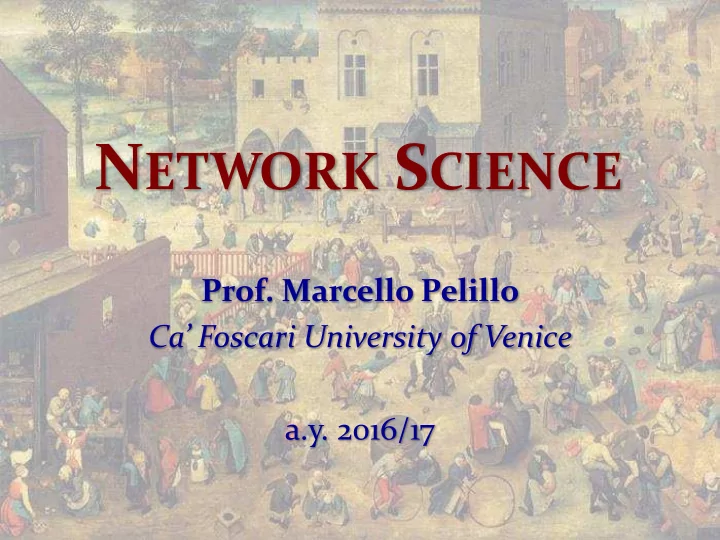

N ETWORK S CIENCE Prof. Marcello Pelillo Ca’ Foscari University of Venice a.y. 2016/17
After 9/11
The terrorist network / 1 Those who were trained to fly didn ’ t know the others. One group of people did not know the other group. Osama Bin Laden
The terrorist network / 2 Muhammad (Atta) from the Egyptian family, was in charge of the group. Osama Bin Laden
Saddam Hussein’s capture of the 214 actors in the total network, there are only 23 actors with direct ties to Saddam Hussein Brian J. Reed (2006)
Emergence of structure The “ Global Salafi Jihad ” social network (Yang, Liu & Sageman, 2006) The clusters correspond to four known terroristic groups: • The Central Staff (Al Qaeda command & control) • Core Arabs (activists from the central Arab region) • Maghreb Arabs (those from North Africa and the North African Diaspora) • Southeast Asians (mostly Indonesians)
Can we predict terrorist attacks?
Social networks Social Network Analysis is a mathematical methodology for connecting the dots — using science to fight terrorism. Connecting multiple pairs of dots soon reveals an emergent network of organization. Valdis Krebs
Zachary’s karate club From the social network of friendships in the karate club, we can find clues to the latent schism that eventually split the group into two separate clubs (indicated by the two different shadings of individuals in the picture).
Social networks can be large … As of the second quarter of 2016, Facebook had 1.71 billion monthly active users https://www.statista.com/statistics/264810/number-of-monthly-active-facebook-users-worldwide/
… and might grow fast
Information networks Left: the citation network of academic papers in which the vertices are papers and the directed edges are citations of one paper by another. Since papers can only cite those that came before them (lower down in the figure) the graph is acyclic -- it has no closed loops. Right: the World Wide Web, a network of text pages accessible over the Internet, in which the vertices are pages and the directed edges are hyperlinks. There are no constraints on the Web that forbid cycles and hence it is in general cyclic. From: M. E. J. Newman, The structure and function of complex networks (2003)
Communities The links among Web pages can reveal densely-knit communities and prominent sites. In this case, the network structure of political blogs prior to the 2004 U.S. Presidential election reveals two natural and well- separated clusters. (Image from http://wwwpersonal.umich.edu/ ladamic/img/politicalblogs.jpg)
Technological networks • Internet • Electric power grid • Network of airline routes • Networks of roads • Railways • Telephone networks • …
Biological networks • Neural networks • Food web • Metabolic pathways • Genetic regulatory networks • …
Basic statistics of some publicly available networks From: M. E. J. Newman, The structure and function of complex networks
Complex Systems Complexity, a scientific theory which asserts that some systems display behavioral phenomena that are completely inexplicable by any conventional analysis of the systems’ [adj., v. kuh m-pleks, kom-pleks; n. kom- pleks] constituent parts. These phenomena, – adjective commonly referred to as emergent behaviour, seem to occur in many 1. complex systems involving living composed of many interconnected parts; organisms, such as a stock market or compound; composite: a complex highway system. the human brain. 2. characterized by a very complicated or Source: John L. Casti, Encyclopædia Britannica involved arrangement of parts, units, etc.: complex machinery. 3. so complicated or intricate as to be hard to understand or deal with: a complex problem. Source: Dictionary.com Network Science: Introduction
Complex Systems Complex systems Made of many non-identical elements connected by diverse interactions . NETWORK Behind each system studied in complexity there is an intricate wiring diagram, or a network , that defines the interactions between the component. We will never understand complex system unless we map out and understand the networks behind them.
Connected: Six Degrees of Separation http://topdocumentaryfilms.com/six-degrees-of-separation/
Course content • Graphs and networks • Game theory • Networks and the WWW • Networks dynamics
Textbooks
The exam • Oral exam • Hands-on activity: – Seminar or – Project development
Recommend
More recommend